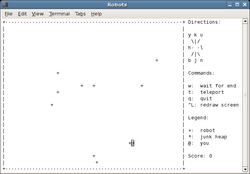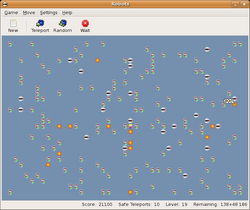Robots (1984 Video Game)
 From Handwiki
From Handwiki robots is a turn-based computer game in which players are tasked with escaping from robots programmed to pursue and kill them. The player attempts to destroy the robots by moving in such a way that the robots collide with each other or other obstacles.
The game was first developed by Allan R. Black in November, 1984. In May 1985, it was posted to the Usenet newsgroup net.sources.games.[1][2] It was then developed for the Unix-based operating system Berkeley Software Distribution by Ken Arnold. The BSD Unix version of robots first appeared in the 4.3BSD software release in June 1986.[3][4]
The basic concept has been part of games stretching into the 1970s, as is among the earliest of the "standards" for microcomputer platforms.
Gameplay

robots is played on a two-dimensional rectangular grid. The objective of the game is to escape from a number of robots, which have been programmed with only a single objective: to kill the player.
The game is turn-based. In the original game the player character starts at a randomly selected location. In some derivative versions, such as the GNOME version, the player starts at the centre of the grid. The robots start at randomly selected locations on the grid. Every time the player character moves a square in any direction (horizontally, vertically, or diagonally), each robot moves one square closer to him, in whichever direction is the shortest path. If the player character collides with a robot, he dies and the game ends.
The player attempts to survive by causing the robots to kill themselves by colliding with other objects on the map. There are two major ways this occurs. In earlier versions, derived from Chase, there are a number of deadly objects on the map that will kill either the robots or the player. In later versions, derived from robots, the map is initially clear and these hazards are created when two robots collide to create a pile of rubble. In either case, the player is attempting to move in such a way to cause the robots to collide with each other or the stationary obstacles.
The player can also teleport into a randomly selected location in cases where escape is otherwise impossible. A teleportation counts as a move. However, because the location is randomly selected, it is possible that the player teleports right into the path of a robot. In some versions of the game, there is a "safe teleport" feature which the player may use a limited number of times (for instance once per level) and there may also be a close-range weapon which kills all robots within the immediate vicinity, the use of which would be limited in a similar way.
A few versions also add a tank, which is not killed when colliding with the other objects, and is deadly to all objects. It otherwise acts like the other robots.
When all robots on a level are dead, the player moves onto another level, with more robots. Traditionally, the number of robots increases by ten each level.

Other versions
In the Jan-Feb 1976 issue of Creative Computing, a game called Chase was published that bears a strong resemblance to robots. The author was originally listed as "Unknown," with modifications made by Bill Cotter on the Honeywell 6000 series.[5][lower-alpha 1] It was republished in 1979's More BASIC Computer Games, suggesting the original author was Mac Oglesby,[6] a prolific game author of Dartmouth BASIC games from the mainframe era.[lower-alpha 2]
A series of relatively direct copies of this game appeared in computer magazines of the era, including one for the SWCP 4k BASIC,[7] and a graphical version using the VDM-1 card for S-100 bus machines.[8]
Many follow-up versions of the game were known as Escape!, although it is not clear when this name was first used. One such version appears in Announcing: Computer Games for the TRS-80, which added another enemy, the tank, and limited the player to two teleports per match.[9] A commercial graphical version of Escape! was also sold by subLOGIC as early as 1982, which added a real-time option that caused the robots to move even if the user didn't. A review of this version in Creative Computing once again attributed the original to Mac Oglesby.[10]
A modified version of Escape! known as Robot Minefield was released in 1983 by Tim Hartnell and Nathan Butcher. This reduced the number of enemies to four and eliminated the tank. In addition, the player could only move in four directions (North, South, East, West) while the robots had the ability to move diagonally. The game was played in real time; as the player pondered his move, the robots would continue converging toward him. This version was published in the 1983 Giant Book of Computer Games.[11][12]
In 1984, Johan Strandberg published a game called Daleks, for the Macintosh One major addition is the Sonic Screwdriver, which could be used once per level and killed any robots within one space of the player.[13]
In May 1985, a very similar game also called robots, written by Allan R. Black, was posted to the Usenet newsgroup net.sources.games.[1][2]
In 1985, Robert Paauwe of Softstar Software developed a derivative called Daleks, for DOS.[14]
In 1987, Graeme Lunt and Julian Onions developed a derivative of Allan Black's code, called robots2, which they posted to the comp.sources.games Usenet newsgroup.[15][16]
In 1989, a variant called Robots from Hell was published by William R. Voss. Played on a screen of blue tiles, the robots can not overlap, nor are scrap heaps formed. There are several humorous elements added to the game, such as comments when the player dies, or text reminding the player they have scrolled past the end of the instructions when viewing the game rules.[17]
In 1991, Nicholas Lonsky published a port called Tobor, for Windows 3.0.[18]
In 1995, Torbjörn Andersson published a derivative called Robots, for the Z-machine.[19]
In 1998, Mark Rae published a derivative called Gnobots, later called GNOME Robots, for GNOME.[20][21]
In 1999, Mark Cenicola of Cenic's Soft published a derivative called Trolls for Mac OS 7.0 or greater.[22]
In 2008, John Matthews published a derivative called RobotChase, for the Java software platform.[23]
See also
- Robotron, a real-time version
Notes
- ↑ The Honeywell 6000 series was a re-badged GE-600 series, which is the same machine as the DTSS system of the same era.
- ↑ In an email, Mac stated he was not the original author of the game. Bill Cotter stated that he saw the original on either a DECUS tape or the Dartmouth Time Sharing System. DECUS shows no similar program. It appears that David H. Ahl was aware of its origins on the DTSS system and naturally ascribed it to Mac based on his prodigious output. The original author remains unknown.
References
- ↑ 1.0 1.1 Stephen J. Muir (May 28, 1985). "Robots game for 4.2 BSD (highly addictive)". Newsgroup: net.sources.games. Usenet: 149@dcl-cs.UUCP. Retrieved August 21, 2015.
- ↑ 2.0 2.1 robots, by Allan R. Black
- ↑ 4.3BSD robots(6) man page
- ↑ 4.3BSD robots source code
- ↑ "CHASE". Creative Computing 2 (1): 75-76. January 1976. https://archive.org/details/Creative_Computing_v02n01_Jan-Feb1976.
- ↑ Chase (additional detail from 1979)
- ↑ "Chase!". Kilobaud: 48-50. February 1977. https://archive.org/stream/kilobaudmagazine-1977-02/Kilobaud_1977_February#page/n49/mode/2up.
- ↑ Singer, Joseph Jay (May 1977). "Video Chase for 8080/VDM". Dr. Dobb's Journal: 10-16. https://archive.org/stream/dr_dobbs_journal_vol_02_201803/dr_dobbs_journal_vol_02#page/n209/mode/2up.
- ↑ Nahigian, J. Victor; Hodges, William (1980). Computer Games : for business, school, and home for the TRS-80 level II Basic. p. 46. https://archive.org/details/Announcing_Computer_Games_for_Business_School_and_Home_1980_Winthrop_Publishers.
- ↑ "Escape!". Creative Computing: 16. August 1982.
- ↑ GameBase64: Robot Minefield
- ↑ Tim Hartnell's Giant Book of Computer Games, p.273: Robot Minefield
- ↑ Daleks, by Johan Strandberg on macintoshgarden.org
- ↑ Daleks, by Robert Paauwe
- ↑ Julian Onions (July 8, 1987). "v01i080: robots2 - Game of robots, version 2". Newsgroup: comp.sources.games. Usenet: 1380@tekred.TEK.COM. Retrieved August 16, 2015.
- ↑ "robots2 - Game of robots, version 2". GitHub. https://github.com/fjarlq/robots2.
- ↑ William R. Voss (1989). "Robots from Hell". archive.org. https://archive.org/details/RobotsFromHell.
- ↑ Tobor, by Nicholas Lonsky
- ↑ Robots, by Torbjörn Andersson
- ↑ Gnobots - Robots game for Gnome, by Mark Rae
- ↑ GNOME Robots
- ↑ "Trolls 1.3.1 - Mark A. Cenicola". http://www.markcenicola.com/cenicsoft/mactrolls/.
- ↑ RobotChase, by John Matthews on sourceforge.net
ru:Robots
Categories: [Linux games] [Open-source video games]
↧ Download as ZWI file | Last modified: 07/27/2024 10:14:03 | 46 views
☰ Source: https://handwiki.org/wiki/Software:Robots_(1984_video_game) | License: CC BY-SA 3.0

 KSF
KSF